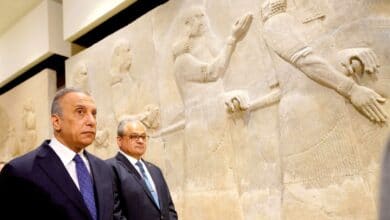Who were the Riace Warriors? Bronze statues telling their secrets

By Gonzalo Sanchez
Rome, Jul 12 (EFE).- Fifty years ago, the Ionic Sea gave up one of its well-guarded secrets – the Riace Bronzes – the extraordinarily well-preserved statues of two Greek warriors that astounded archaeologists worldwide.
But, who were those warriors from the ocean depths? A study presented on Tuesday in Rome tentatively established their identity, placing their origin in Athens about 460-450 BC.
“After considering and weighing all the details this reconstruction was able to be made. I’m pretty convinced of this hypothesis. I believe that it’s a very interesting idea,” said the director general for Italy’s museums, Massimo Ossana, during the presentation of the study at the Curia Julia at the Roman Forum in the Italian capital.
The investigation was conducted by German archaeologists Vinzenz Brinkmann and Ulrike Koch, with the Liebieghause Sculpture Collection Museum in Frankfurt, and was presented in the Eternal City to commemorate the 50th anniversary of the discovery of the famous Greek statues.
The Riace Bronzes, known as Bronze A and Bronze B, were found at the bottom of the Ionic Sea, 200 meters (yards) off the coast of Calabria from which they take their name, on Aug. 16, 1972, by photographer Stefano Mariottini, who was snorkeling at the time, the find astounding worldwide experts, who since then have made the journey to the remote Italian area to admire them.
The bronzes – which were probably submerged in a shipwreck – depict two completely naked “hoplites” (infantry warriors), with curly hair and beards, standing 1.98 meters (78 inches) high and weighing 160 kilograms (352 pounds). According to the position of their arms, the statues are each thought to have originally held a weapon and a shield, although these items have disappeared, possibly being made of wood.
Nevertheless, much has been written about the identity of these two figures, who have been dubbed Polynices and Eteocles, two of the sons that Oedipus has with his mother Jocasta.
The German experts have performed a rigorous study to determine the identity of these two warriors delving into their ethnic origins by examining the statues and comparing them to other examples of warriors on Greek amphorae and in written records.
According to Prof. Brinkmann, the warriors can be none other than Erechtheus, the ancient king of Athens and the lord of the Thracians, and Eumolpos, the son of Poseidon and the legendary king of Thrace, who faced off in a mythic war that the former won, resulting in Athens’ victory over its northern neighbors.
“The key question was to reconstruct the color of the skin to know the ethnic context of the characters, but this also could be clarified by looking into the activity in which they were engaged,” he said.
For example, Bronze B, which is in a worse state of preservation, shows a flexed finger, and this – experts say – proves that he was holding a bow and arrows under a shield, as other finds indicate, such as the Persian rider from the temple of Aphaea on Aigina.
In the left hand, the bronze was carrying a battle-axe while studies show that on the head was an ornate helmet. “We understand that he must have been a Thracian according to his weapons,” the expert said.
Bronze A, the investigation found, wore a typical Greek helmet, and in his left hand carried a circular shield while in the right held a large spear resting on his shoulder.
But there is one further factor that differentiates the two figures, namely the fact that the sculpture that allegedly represents the Athenian king has silver teeth, a sign of his royal ferocity.
Brinkmann suggested that the two warriors at some point were displayed facing one another, a sign of challenge, and that they could have once stood in the Acropolis, as per the writings of Pausanias.
The director of the Coliseum Archaeological Park, Alfonsina Russo, called the research “very convincing,” adding that “it provides a new view of the ancient bronzes” by opening up other scenarios.
The German experts made replicas of both figures and took pains to color and outfit them as they may originally have been to display them at the “Ancient Sculpture in Color” exhibition at New York’s Metropolitan Museum of Art through March 2023.
The Riace Bronzes are considered to be two of the most outstanding and best-preserved sculptures from Ancient Greece, despite the fact that they were submerged in the ocean for centuries.
Since they were found, they have been conserved, housed and displayed at the National Archaeological Museum of Calabria, with that region once being a Ancient Greek colony, but this year a special program was prepared to commemorate the 50th anniversary of their discovery. EFE





